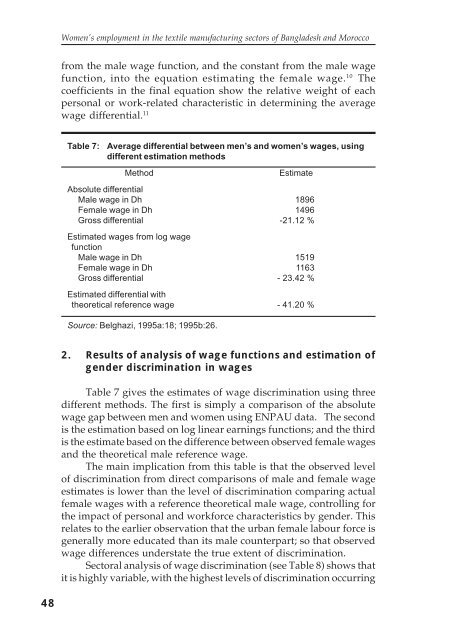Women's Employment - United Nations Research Institute for Social ...
Women's Employment - United Nations Research Institute for Social ...
Women's Employment - United Nations Research Institute for Social ...
You also want an ePaper? Increase the reach of your titles
YUMPU automatically turns print PDFs into web optimized ePapers that Google loves.
Women’s employment in the textile manufacturing sectors of Bangladesh and Morocco<br />
from the male wage function, and the constant from the male wage<br />
function, into the equation estimating the female wage. 10 The<br />
coefficients in the final equation show the relative weight of each<br />
personal or work-related characteristic in determining the average<br />
wage differential. 11<br />
Table 7: Average differential between men’s and women’s wages, using<br />
different estimation methods<br />
Method<br />
Estimate<br />
Absolute differential<br />
Male wage in Dh 1896<br />
Female wage in Dh 1496<br />
Gross differential -21.12 %<br />
Estimated wages from log wage<br />
function<br />
Male wage in Dh 1519<br />
Female wage in Dh 1163<br />
Gross differential - 23.42 %<br />
Estimated differential with<br />
theoretical reference wage - 41.20 %<br />
Source: Belghazi, 1995a:18; 1995b:26.<br />
2. Results of analysis of wage functions and estimation of<br />
gender discrimination in wages<br />
Table 7 gives the estimates of wage discrimination using three<br />
different methods. The first is simply a comparison of the absolute<br />
wage gap between men and women using ENPAU data. The second<br />
is the estimation based on log linear earnings functions; and the third<br />
is the estimate based on the difference between observed female wages<br />
and the theoretical male reference wage.<br />
The main implication from this table is that the observed level<br />
of discrimination from direct comparisons of male and female wage<br />
estimates is lower than the level of discrimination comparing actual<br />
female wages with a reference theoretical male wage, controlling <strong>for</strong><br />
the impact of personal and work<strong>for</strong>ce characteristics by gender. This<br />
relates to the earlier observation that the urban female labour <strong>for</strong>ce is<br />
generally more educated than its male counterpart; so that observed<br />
wage differences understate the true extent of discrimination.<br />
Sectoral analysis of wage discrimination (see Table 8) shows that<br />
it is highly variable, with the highest levels of discrimination occurring<br />
48
















